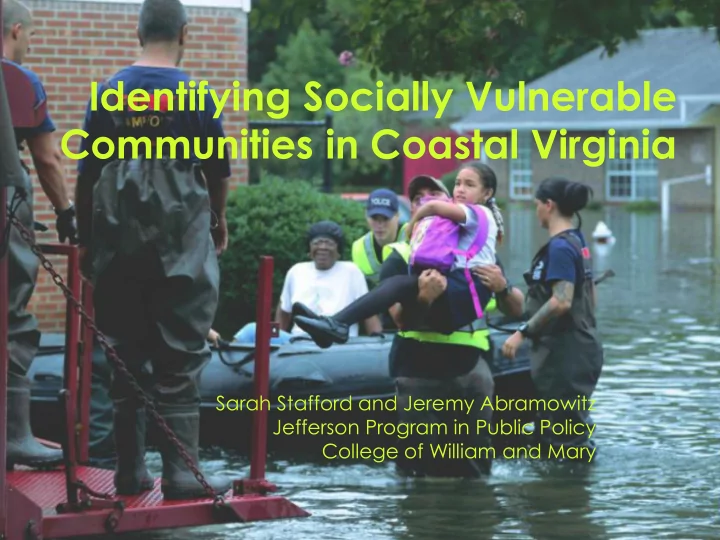

Identifying Socially Vulnerable Communities in Coastal Virginia Sarah Stafford and Jeremy Abramowitz Jefferson Program in Public Policy College of William and Mary
One option: Use data to identify areas with populations that are likely to have a difficult time reacting to or recovering from a natural disaster.
Pros: • Uses readily available data. • No need to expend limited resources to conduct your own data collection/assessment. • May identify areas that would otherwise “slip” through the cracks. • May help demonstrate compliance with Environmental Justice requirements.
Pros: Cons: • Uses readily available data. • Only uses readily available • No need to expend limited data, which is collected for resources to conduct your lots of other purposes, not own data specifically to identify collection/assessment. socially vulnerable • May identify areas that communities. • Can’t look at each would otherwise “slip” through the cracks. community individually or • May help demonstrate completely. compliance with Environmental Justice requirements.
Social Vulnerabilty Index (SoVI) • Uses Principal Component Analysis to reduce a large matrix of data to a single index of vulnerability. • Larger values indicate a more vulnerable community. • All values are relative – there is no absolute measure of vulnerability.
What Data is Used? • Different sets of variables have been used for different iterations, but generally includes: – Age (mean age; pct. over 65, under 5) – Race (pct. Black, Hispanic, Asian, Native American) – Financial status (mean income, house value, and rent; pct. in poverty, unemployed, receiving soc. security) – Household characteristics (pct. female head of household, renter, living in mobile homes; mean number in household) – Other (pct. employed in service industries, extractive industries; pct. in nursing homes, without HS degree; pct. Female labor force participation)
Limitations of SoVI – Geographic scope and level of analysis affects the determination of vulnerability. – Interpretation is difficult. – Tracts that “hit” on lots of different factors score higher than tracts that hit on just one factor, but one factor alone may be enough to make a community vulnerable. – Not as objective as it might seem. • The researcher must use her judgment at various steps in the process because the relationship between the different data elements and vulnerability is not always obvious or uni- directional.
Alternative Approach • Rather than reduce a large matrix of data to a single index of vulnerability, we are using a cluster analysis to identify different “sets” of census tracts that look similar to each other. • We can then look at the characteristics of each set and determine whether tracts in that set are socially vulnerable.
Cluster Analysis • Pros – Identifies tracts that may be vulnerable in only one or two dimensions. – Allows factors to be considered holistically. – Allows researchers to make the vulnerability determination. • Limitations – Researchers have to make value judgments. – Clustering process can miss some vulnerable tracts and can include non-vulnerable tracts.
Preliminary Categorization for all of Virginia Each set of census tracts has a different color. Tracts in red, orange and yellow are more vulnerable. Tracts in blue, purple and green are less.
Preliminary Categorization for Coastal Virginia Each set of census tracts has a different color. Tracts in red, orange and yellow are more vulnerable. Tracts in blue, purple and green are less.
Using the Results • Regardless of which data-driven method used is used, the results need to be validated. – We plan to “ground - truth” the results of both the SoVI and cluster analysis by holding focus groups with community leaders to see which communities are successfully identified and which are missed. • We also need to evaluate how well any vulnerability measure predicts a community’s resilience. – To do this, we need to find a robust measure of resilience as well as appropriate events that test a community’s resilience.
Recommend
More recommend